Spring has finally arrived and crops now have a chance to catch up. With one tomato grower reporting returns down 90% in early March this will be much needed. However, the coming months are very difficult to predict. Large cuts in spending are inevitable with the new administration, and horticulture will not be immune, but we must wait to find where they will fall.
Editor
Work in a Botanic Garden
In the next few weeks members will have the opportunity to visit the Botanic Gardens at Wakehurst (18 May), Cambridge (10 June) and Oxford (11 June). Alison Foster has answered a few questions to give an insight into her own work at the Oxford Botanic Garden:
What is your role at the University of Oxford Botanic Garden?
I am a glasshouse horticulturalist, working as part of a team of three full time in the glasshouses. Since my background is as a chemist I also have a special interest in pharmaceutically important plants and have been planning a new pharmaceutical plants area for the garden.
What are the greatest challenges for you?
Getting everything done in the time available to the high standards required. We have an enormously diverse collection of plants in quite a limited space and they all have their individual requirements so balancing a general approach with attention to detail is very important.
What do you like best about the work?
The amazing range of plants is fantastic and inspiring to be around on a daily basis and so are my colleagues. Talking to our visitors about what we do is also very rewarding.
What exciting/interesting/unexpected discoveries have you made?
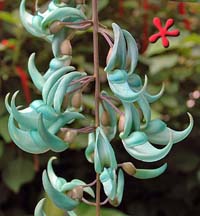
Photo: Jade vine, Zone 9 Tropicals
What is your favourite plant/area of the garden and why?
That’s a really hard question to answer as each day it is probably different. I love the diversity of the glasshouses but I think if pushed my favourite plant through the year is the Katsura tree, Cercidiphyllum japonicum, which is in the walled garden. It is the first tree into leaf, with beautiful heart shaped leaves, initially red then turning green and the first to colour in the autumn. As it turns yellow and red, a wonderful caramel smell wafts out – fantastic. I am also extremely excited about the new developing pharmaceutical plants area, the construction of which is currently underway.
How does the location of the garden in this historic university city affect your role/the garden?
The garden is the oldest botanic garden in the country and so many of our visitors are interested in the historical aspects of the garden. All the staff are happy to answer questions as best we can. We have many visitors who first came to the garden when they were students and come back sometimes many years later to see what has changed and what has stayed the same. When we are working it is sometimes easy to forget to stop, just for a few seconds and look up at our awe-inspiring surroundings.
How far has your knowledge of chemistry helped you?
Studying chemistry has been enormously helpful. I love to find out about what natural products particular plants make, and how they may help the plant to be better adapted to their environment or survive predator attack etc. My knowledge of chemistry enables me to understand what I read and then tell the stories to the visitors or my colleagues in less technical language. I have done several guided tours where I have talked about some of the interesting chemistry-related stories and the feedback is great. Learning about chemistry that is happening in plants is a really good way of introducing the subject to people who think that all chemistry is bad!
Have you noticed that your membership of SCI and active participation in the horticulture group committee is helping your career?
Yes it is. The networking aspect in particular has been very useful whilst I have been planning the new pharmaceutical plants area for the garden. I have been able to make contact with relevant people and find out information I would otherwise have struggled to get. I have been a member of the SCI for approximately 10 years and did have to actively decide whether to stay a member when I left my chemistry job. However, the new horticulture group started just at the right time and this in particular made me renew my membership. I am looking forward to being involved more and more in the future.
Plants of the Month
Davidia involucrata (Nyssaceae)
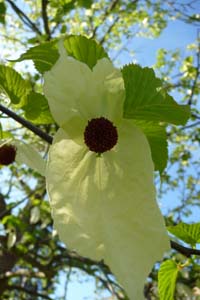
The common names give a good idea of how to spot this tree at this time of year. The white 'handkerchiefs' , 'ghosts' or 'doves' hanging all over the tree are actually bracts (modified leaves) surrounding the true inflorescence. When the bracts first emerge they are small and green and over the course of a few weeks they enlarge and then loose the chlorophyll until they are white. There are two bracts, which are unsymmetrical surrounding the inflorescence. The inflorescence is composed of a single female flower (which has aborted stamens) surrounded by multiple male flowers with dark purple stamen. The lone female flower is set off-centre and angled towards the larder of the two bracts. Recent research has shown that the bracts alert the pollinators when the flowers are mature and the anthers have dehisced as well as protecting the pollen from the heavy rains that typically occur when the tree is flowering in its native land.
Davidia commonly takes upwards of 15-20 years to reach maturity and flower but a cultivar 'Sonoma' is now available which will flower from much younger and smaller plants. This cultivar is available from Bluebell Nurseries near Ashby de la Zouch.
Medicinal Plant of the Month: Bluebell - Hyacinthoides non-scripta
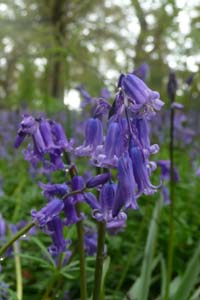
Bluebells were recorded as a treatment for leprosy in Wales in the 13th century. Both leprosy and TB are caused by species of Mycobacterium which require glycosidase enzymes to add carbohydrates correctly in their cell walls as they grow. Bluebells contain chemicals known as iminosugars which have been shown to inhibit these glycosidases. It is therefore possible that iminosugars found in plants such as bluebells offer a potential method for controlling such mycobacterial infections. Bluebells are generally considered to be toxic but one native animal is known to eat them. Is it possible that badgers are treating themselves for bovine TB?
Alison Foster
Horticulture Industry News
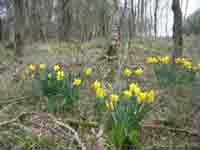
RISC is a project to engage the public in monitoring non- native species, under contract with Defra. The scheme will supplement the larger non-natives project, Great Britain’s Non Native Species Secretariat (Hort Week, 2nd April 2010) More and More
Public still very much against GM
'Resistance by consumers and supermarkets and attacks on trial sites in the UK virtually closed down the UK trials programme,' said Professor Jim Dunwell, University of Reading.' The consequence of trials not being conducted and commercial companies taking their expertise elsewhere is that science around GM has declined dramatically. Twenty years ago there were 12 biotechnology companies in the UK and now there are no companies producing GM material in the UK. Instead they are doing that work in China and the United States' (South East Farmer, April 2010).
However...
DEFRA has granted approval for Leeds University to conduct a second research trial of genetically modified potatoes this year. The focus of the research will be on tubers that have been genetically modified to resist infection by potato cyst nematodes (Fresh Produce Journal, 16 April 2010)
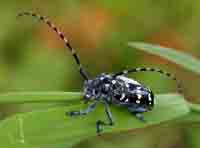
UK import regulations have been stepped up in a bid to prevent Citrus Longhorn beetle, spreading to the UK, where it could be devastating to ornamental shrubs in UK parks and gardens. Seventeen hosts including Cotoneaster, Betula and a particular favourite is apparently Acer palmatum.
Watch your Petunias
Fera are providing advice on action to be taken following the finding of Tomato chlorotic dwarf viroid on petunias imported into the UK. TCDVd causes few symptoms in ornamental hosts - some puckering and distortion of the leaves and yellowing of the veins was observed in infected plants in 2007, but these symptoms seemed to be transient. However TCDVd can infect tomato crops where it causes serious problems. (NFU Horticulture & Potato News, 23 April 2010)

The Jim Mount Centre at East Malling is a collaborative venture between NRI and East Malling Research (EMR). It combines EMR’s facilities and expertise on UK horticulture with NRI’s expertise on tropical crops. Neil Hipps, EMR’s Business Development Manager, said that the partnership would create the 'widest ranging post-harvest research with the best facilities in the country'.
Checking plant names
One way of finding out the currently accepted name for a plant is to use a reliable checklist. Lists are becoming increasingly available on the web (Australian Horticulture, March 2010) e.g.
International Plant Names Index
Royal Botanic Gardens Kew Electronic Plant Information Centre
Flora Europaea
Royal Botanic Gardens Edinburgh
RHS Plant Finder
A list of cultivars published by International Cultivar Registration authorities is available on the International Society of Horticultural Science website
LED Lighting
Light-emitting diodes, or LEDs are beginning to be talked about as a potential alternative to conventional lighting for some horticultural uses. Phillips Lighting is trialling LED lighting in tomato production where results suggest a mix of high pressure sodium (HPS) lamps and LEDs can increase yields by 15%. LED lighting is at present both too expensive and less energy efficient than HPS for supplementary lighting. Where it may have a function, however, is in prompting specific growth responses at certain stages in a crop cycle, such as in germination of seed or rooting cuttings. (Commercial Greenhouse Grower, April 2010).
Shortage of good candidates
'Gone are the days when there were lots of candidates with ten years or more horticultural experience' says Guy Moreton. ' There is a nucleus of good horticultural colleges but the courses have changed and so have the candidate’s opinions of what they want to do. What some courses don't teach is how to run a business and that should be the focus for the future' . Meanwhile Martin Emmett of the School of Biological Sciences at Reading University is working on a new generation of courses with the Horticultural Trades Association (HTA) who have received £120,000 worth of funding from the HDC and Knowledge Transfer Partnership (KTP) to research over a two year period what commercial horticulture courses are needed to produce the best growers in the future (The Commercial Greenhouse Grower, April 2010).

The UK office fruit delivery company Fruitful Office supplies baskets of fruit. Commercial buyer Niels Bischoff says ' having fruit in the office does go a long way to making for a happier workplace. It is an investment for companies into their workforce' The company has had to fend off nine copycat firms in the last four years, (Fresh Produce Journal, 16 April 2010). I am surprised supermarkets do not offer baskets of fruit as an alternative to flowers!
Edible Flowers
Could edible flowers be profitable for the fresh produce industry? Edible flowers have been prized for centuries for their taste, texture, visual appeal and medical properties. Adding an edible flower to a cocktail makes it look special and edible flowers added to a green salad encourages customers to pay for the 'wow' factor. (Fresh Produce Journal, 2 April 2010).
Root hairs switched on
Scientists from the John Innes Centre and the University of Oxford have discovered which genes control the specialized nutrient mining machine that develops on the surface of plant roots. It has long been known that when crops such as barley and wheat are grown on soils containing small amounts of phosphate, those plants with long hairs give higher yields than those with short hairs.
They discovered that a master regulatory gene called RSL4 acts like a switch; hair cells grow when the gene is turned on and growth stops when it is off. When plants grow in conditions where there is insufficient phosphate they develop very long root hairs. This increases the amount of soil from which they can scavenge phosphate.
Our hope is that in the future someone will be able to use this gene to develop cultivars which enhance yields on poor soils.
UK Struggles
A report by the Science and Technology Committee finds that the UK is struggling to translate its excellent research base in bioengineering into health and wealth despite the fact that economic recovery will depend, in part, on exploitation of the UK' s research base.
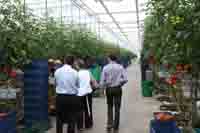
Plans are afoot to expand the largest single tomato-growing glasshouse in the country. A planning application has been submitted to add another 7.5ha to the glasshouse site. This will take it up to 18.2ha of glass and could create 150 jobs. If the plans are approved, all the new space will house tomatoes. Nursery manager Nigel Bartle, claims it is impossible to saturate the market with too many tomatoes, even with grower competitors like Kent' s Thanet Earth. ' Of the tomatoes sold in this country, 80 per cent are imported and 20 per cent are British-grown. We already supply about 10 per cent of that 20 per cent, but that means we only supply two per cent of the market and Thanet Earth supply less’, he notes. (Hort Week, 1 April 2010)
EU urged to take action
The organisation representing farmers and growers in Europe (COPA/COGECA) has called for improved support for fruit and vegetable producers to avert a crisis. The move follows a meeting of European growers representatives in March which outlined the drop in producers incomes in 2009. In 2009 the value of production for fruit fell by as much as 12.7% with producers incomes dropping by 12%. To avert a crisis the EU Commission has been asked to improve measures designed to support producers in times of crisis. (NFU Horticulture & Potato News, 9 April 2010)
For peat’s sake…..
A Defra commissioned report has concluded that the future availability of suitable peat replacement material will be insufficient to permit a faster rate of peat reduction than is occurring currently. According to the report, the projected total volume of alternatives available to the UK growing media industry in 2020 will be 3,420,000 m3. To be 100% peat free by 2020 the amateur gardening growing media market will require 3,080,000 m3 – leaving just 340,000 m3 of alternatives available for professional growers. The report projects professional grower’s total demand for growing media to be 1,114,000 m3 in 2020. (NFU Horticulture & Potato News, 9 April 2010)
Wonky veg ban beaten
An attempt to give wonky produce the chop and reinstate a European Union-wide ban on ' non-standard' fruit and vegetables has failed. Spanish MEPs had demanded that strict rules governing the size and appearance of some fruit and vegetables be reintroduced. However, the proposal was defeated at the European Parliament amid arguments that it would increase food wastage. (NFU Horticulture & Potato News, 9 April 2010)
New potato pest threat
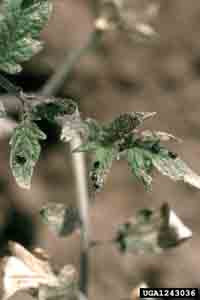
Photo: E. Cucumeris damage on tomato, Whitney Cranshaw, Colorado State University
Reprieve for cider
Growers supplying the resurgent cider industry look likely to benefit from 11th-hour changes to the UK Finance Bill, after the controversial 10% increase in duty on all ciders was de-railed by the pre-election ' wash-up’. (NFU Horticulture & Potato News, 9 April 2010)
Quotes of the Month

Newton, forgive me. - Albert Einstein
The photo shows Paul Valéry (everyone knows what Einstein looks like!)
Events Calendar
SCI Events
New Technologies in Synthesis and Medicinal Chemistry
11 May 2010, Fine Chemicals Group
Novartis Horsham Research Centre, West Sussex
Tour of Stockbridge Technology Centre - new
13 May 2010, Horticulture Group
STC is a horticultural research centre covering 180 acres including modern greenhouses and laboratories.
Millennium Seed Bank Tour
18 May 2010, Horticulture Group
Wakehurst Place, Ardingly, UK
The World is Hungry for Food and Energy
20 May 2010, BioResources Group
SCI HQ, Belgrave Square, London, UK
Market Inspired Innovation: Using Customer Insight to Drive Tomorrow' s Growth
20 May 2010, Science and Enterprise Group
Langstone Technology Park, Havant, UK
Private Evening Tour of Cambridge University Botanic Garden
10 Jun 2010, Cambridge and Great Eastern Group
Cambridge University Botanic Garden, Cambridge, UK
Evening Tour at Oxford Botanical Garden
11 June 2010, Horticulture Group
Rose Lane, Oxford
SCI Annual General Meeting 2010
07 Jul 2010,
SCI Headquarters, London, UK
Other Events of Interest
National Hardware Show
4 May 2010 - 6 May 2010
Las Vegas, USA
Non-food uses of crops
10 May 2010 -11 May 2010, Association of Applied Biologists
Wyboston, Bedfordshire, UK
Natural Turf for Sport - Engineering Safe and Sustainable Surfaces
11 May 2010, Institution of Agricultural Engineers
Cranfield University, Bedfordshire, UK
Global Berry Congress
12 May 2010, Eurofruit
London, UK
Re:Fresh
13 May 2010
London, UK
International Symposium on Microbial Horticulture
16 May 2010 - 20 May 2010, International Society for Horticultural Science
Alnarp, Sweden
British Tomato Week
17 May 2010 - 23 May 2010, British Tomato Growers Association
various locations, UK
Campaign for the Farmed Environment
19 May 2010, British Institute of Agricultural Consultants / Country Landowners Asociation
Marlborough, Wilts, UK
BIAC Spring Conference and AGM
20 May 2010, British Institute of Agricultural Consultants
SCI HQ, London, UK
Chelsea Flower Show
25 May 2010 - 29 May 2010, Royal Horticultural Society
London, UK
Advances in molecular plant breeding
8 Jun 2010 - 9 Jun 2010, Association of Applied Biologists
Rothamsted Research, Harpenden, UK
IAFP European Symposium on Food Safety
9-11 Jun 2010, International Association for Food Protection
University College, Dublin, Ireland
4th Global Botanic Gardens Congress
13 Jun 2010 -18 Jun 2010, Botanic Gardens Conservation International
Glasnevin, Dublin, Ireland
International Medicinal and Aromatic Plants Symposium
21Jun 2010 - 24 Jun 2010, International Society for Horticultural Science
Shiraz, Iran
Agriculture Outlook Europe
23 Jun 2010 - 25 Jun 2010, Food Chain
Millenium Mayfair Hotel, London, UK
Landscape management for functional biodiversity
29 Jun 2010 – 1 Jul 2010, International Organisation for Biological & Integrated Control of Noxious Aminals & Plants
Cambridge, UK
International Symposium on Improving the Performance of Supply Chains in the Transitional Economies
4 Jul 2010 - 8 Jul 2010, International Society for Horticultural Science
Kuala Lumpur, Malaysia
International Trials Conference: Assessment of Ornamental Plants
6 Jul 2010 - 8 Jul 2010, International Society for Horticultural Science
Guildford, UK
Ohio Short Course
10 Jul 2010 -13 Jul 2010, Ohio Growers Association
Columbus, USA
Woking Nursery Exhibition
14 Jul 2010, Woking Nurseries
Merrist Wood College, Worplesdon, Surrey, UK
Fruit Focus
21 Jul 2010, Haymarket
East Malling, UK
Eastgro
4 Aug 2010
Petistree, Suffolk, UK
International Horticultural Congress
22 Aug 2010 - 27 Aug 2010, International Society for Horticultural Science
Lisbon, Portugal
Plantarium
25 Aug 2010 - 28 Aug 2010
Boskoop, the Netherlands
International Advances in Plant Virology
5 Sep 2010 - 7 Sep 2010, Association of Applied Biologists
Arnhem, the Netherlands
Four Oaks Trade Show
7-8 Sep 2010
Lower Withington, Cheshire, UK
If you would like to advertise a forthcoming event please contact communications@soci.org.
Horticulture Group Contact Details
For submitting ideas or to volunteer to be part of a committee or a group, please contact:
Acting Chairman - Peter Grimbly
Meetings Secretary - Marion Stainton
Minutes Secretary - Margaret Waddy
Newsletter co-ordinator - Sue Grimbly scihortigroup@btinternet.com
SCI contact - communications@soci.org T: +44(0)20 7598 1500
